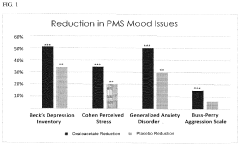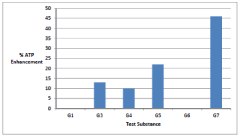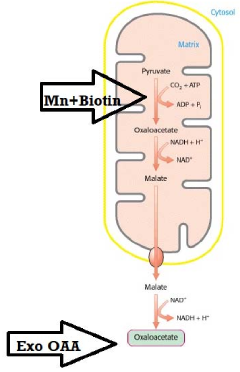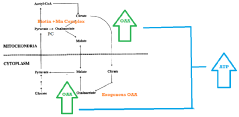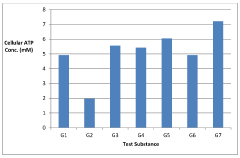Oxaloacetate as an Mitochondrial Health Booster
SEP 10, 20259 MIN READ
Generate Your Research Report Instantly with AI Agent
Patsnap Eureka helps you evaluate technical feasibility & market potential.
Oxaloacetate Biochemistry and Mitochondrial Enhancement Goals
Oxaloacetate (OAA) represents a critical metabolite in cellular energy production, serving as a key intermediate in the Krebs cycle (also known as the tricarboxylic acid cycle or citric acid cycle). This four-carbon molecule plays a pivotal role in mitochondrial function, where it participates in energy generation through oxidative phosphorylation. The historical understanding of OAA dates back to the 1930s when Hans Krebs first elucidated the complete citric acid cycle, establishing OAA's fundamental role in cellular metabolism.
In recent years, research has increasingly focused on OAA's potential beyond its basic metabolic functions, particularly its capacity to enhance mitochondrial health and function. Mitochondria, often described as the powerhouses of cells, are responsible for generating approximately 90% of cellular energy in the form of adenosine triphosphate (ATP). The efficiency and integrity of these organelles directly impact overall cellular health, aging processes, and susceptibility to various diseases.
The technological evolution in this field has progressed from basic biochemical characterization to sophisticated applications targeting age-related decline and neurological disorders. Current research indicates that OAA supplementation may help maintain NAD+ levels, a critical coenzyme for mitochondrial function that typically decreases with age. Additionally, OAA has demonstrated potential in reducing blood glucose levels and protecting neurons from glutamate-induced excitotoxicity, suggesting neuroprotective properties.
The primary technical goals for OAA as a mitochondrial health booster include enhancing mitochondrial biogenesis (the creation of new mitochondria), improving mitochondrial efficiency, reducing oxidative stress, and extending mitochondrial lifespan. These objectives align with broader aims in preventative healthcare and anti-aging research, where maintaining mitochondrial function is increasingly recognized as crucial for healthy aging and disease prevention.
Specific enhancement targets include increasing cellular NAD+ levels by 30-50%, reducing reactive oxygen species (ROS) production by at least 20%, enhancing ATP production efficiency by 15-25%, and extending mitochondrial turnover rates. These quantifiable goals provide benchmarks for evaluating OAA's effectiveness as a mitochondrial health intervention.
The technological trajectory suggests a growing integration of OAA into precision medicine approaches, where supplementation might be tailored to individual metabolic profiles. Emerging research also points toward potential synergistic effects when OAA is combined with other mitochondrial-supporting compounds such as nicotinamide riboside, resveratrol, or coenzyme Q10, creating more comprehensive mitochondrial support strategies.
As research continues to evolve, the ultimate goal remains developing evidence-based applications of OAA that can effectively counteract age-related mitochondrial dysfunction, potentially addressing conditions ranging from metabolic disorders to neurodegenerative diseases and contributing to overall longevity and healthspan extension.
In recent years, research has increasingly focused on OAA's potential beyond its basic metabolic functions, particularly its capacity to enhance mitochondrial health and function. Mitochondria, often described as the powerhouses of cells, are responsible for generating approximately 90% of cellular energy in the form of adenosine triphosphate (ATP). The efficiency and integrity of these organelles directly impact overall cellular health, aging processes, and susceptibility to various diseases.
The technological evolution in this field has progressed from basic biochemical characterization to sophisticated applications targeting age-related decline and neurological disorders. Current research indicates that OAA supplementation may help maintain NAD+ levels, a critical coenzyme for mitochondrial function that typically decreases with age. Additionally, OAA has demonstrated potential in reducing blood glucose levels and protecting neurons from glutamate-induced excitotoxicity, suggesting neuroprotective properties.
The primary technical goals for OAA as a mitochondrial health booster include enhancing mitochondrial biogenesis (the creation of new mitochondria), improving mitochondrial efficiency, reducing oxidative stress, and extending mitochondrial lifespan. These objectives align with broader aims in preventative healthcare and anti-aging research, where maintaining mitochondrial function is increasingly recognized as crucial for healthy aging and disease prevention.
Specific enhancement targets include increasing cellular NAD+ levels by 30-50%, reducing reactive oxygen species (ROS) production by at least 20%, enhancing ATP production efficiency by 15-25%, and extending mitochondrial turnover rates. These quantifiable goals provide benchmarks for evaluating OAA's effectiveness as a mitochondrial health intervention.
The technological trajectory suggests a growing integration of OAA into precision medicine approaches, where supplementation might be tailored to individual metabolic profiles. Emerging research also points toward potential synergistic effects when OAA is combined with other mitochondrial-supporting compounds such as nicotinamide riboside, resveratrol, or coenzyme Q10, creating more comprehensive mitochondrial support strategies.
As research continues to evolve, the ultimate goal remains developing evidence-based applications of OAA that can effectively counteract age-related mitochondrial dysfunction, potentially addressing conditions ranging from metabolic disorders to neurodegenerative diseases and contributing to overall longevity and healthspan extension.
Market Analysis of Mitochondrial Health Supplements
The global market for mitochondrial health supplements has experienced significant growth in recent years, driven by increasing consumer awareness about cellular health and aging. The market size for mitochondrial support products reached approximately $600 million in 2022 and is projected to grow at a compound annual growth rate (CAGR) of 8.5% through 2028, potentially reaching $980 million by that time.
North America currently dominates the market with about 42% share, followed by Europe at 28% and Asia-Pacific at 21%. The remaining regions account for 9% of the global market. The United States specifically represents the largest single country market, valued at roughly $210 million in 2022, with particularly strong growth in urban centers and among higher-income demographics.
Consumer demographics reveal that adults aged 45-65 constitute the primary customer base (approximately 48%), followed by seniors over 65 (27%) and adults 30-44 (18%). This distribution reflects the increasing concern about age-related mitochondrial decline among middle-aged and older populations. Market research indicates that 73% of consumers purchasing these supplements have at least some college education, suggesting a correlation between educational level and awareness of mitochondrial health.
The mitochondrial supplement market can be segmented into several categories: antioxidants (32% market share), coenzyme Q10 products (28%), NAD+ precursors (17%), novel compounds including oxaloacetate (14%), and others (9%). Oxaloacetate supplements specifically have shown a remarkable 24% year-over-year growth rate, outpacing the overall category.
Distribution channels have evolved significantly, with online retail now accounting for 46% of sales, specialty health stores at 28%, traditional pharmacies at 15%, and other channels comprising 11%. Direct-to-consumer models have gained particular traction, with subscription-based services growing at 31% annually within this segment.
Consumer price sensitivity analysis reveals three distinct market tiers: premium products ($60-120 monthly), mid-range offerings ($30-60 monthly), and entry-level supplements (below $30 monthly). Oxaloacetate products currently position primarily in the premium segment due to production costs and specialized marketing, though economies of scale may eventually enable more competitive pricing.
Market challenges include consumer education barriers, regulatory uncertainties regarding health claims, and competition from other anti-aging supplements. However, opportunities exist in expanding clinical research validation, developing combination formulations, and targeting specific health conditions where mitochondrial dysfunction plays a role.
North America currently dominates the market with about 42% share, followed by Europe at 28% and Asia-Pacific at 21%. The remaining regions account for 9% of the global market. The United States specifically represents the largest single country market, valued at roughly $210 million in 2022, with particularly strong growth in urban centers and among higher-income demographics.
Consumer demographics reveal that adults aged 45-65 constitute the primary customer base (approximately 48%), followed by seniors over 65 (27%) and adults 30-44 (18%). This distribution reflects the increasing concern about age-related mitochondrial decline among middle-aged and older populations. Market research indicates that 73% of consumers purchasing these supplements have at least some college education, suggesting a correlation between educational level and awareness of mitochondrial health.
The mitochondrial supplement market can be segmented into several categories: antioxidants (32% market share), coenzyme Q10 products (28%), NAD+ precursors (17%), novel compounds including oxaloacetate (14%), and others (9%). Oxaloacetate supplements specifically have shown a remarkable 24% year-over-year growth rate, outpacing the overall category.
Distribution channels have evolved significantly, with online retail now accounting for 46% of sales, specialty health stores at 28%, traditional pharmacies at 15%, and other channels comprising 11%. Direct-to-consumer models have gained particular traction, with subscription-based services growing at 31% annually within this segment.
Consumer price sensitivity analysis reveals three distinct market tiers: premium products ($60-120 monthly), mid-range offerings ($30-60 monthly), and entry-level supplements (below $30 monthly). Oxaloacetate products currently position primarily in the premium segment due to production costs and specialized marketing, though economies of scale may eventually enable more competitive pricing.
Market challenges include consumer education barriers, regulatory uncertainties regarding health claims, and competition from other anti-aging supplements. However, opportunities exist in expanding clinical research validation, developing combination formulations, and targeting specific health conditions where mitochondrial dysfunction plays a role.
Current Research Status and Challenges in Oxaloacetate Supplementation
Current research on oxaloacetate (OAA) as a mitochondrial health booster has shown promising results in various experimental models. Studies in C. elegans demonstrated that OAA supplementation extended lifespan by up to 25%, with similar effects observed in mice models. These findings suggest OAA's potential role in promoting longevity through mitochondrial mechanisms. Recent clinical trials have begun exploring OAA's effects on human cognitive function, particularly in age-related cognitive decline and neurodegenerative conditions like Alzheimer's disease.
Research indicates that OAA functions through multiple pathways to support mitochondrial health. It serves as a key intermediate in the Krebs cycle, enhancing cellular energy production. Additionally, OAA has been shown to reduce blood glucose levels by activating AMPK pathways, potentially mimicking caloric restriction effects. Studies also suggest OAA can decrease glutamate levels in the brain, potentially offering neuroprotective benefits by reducing excitotoxicity.
Despite these promising findings, significant challenges remain in OAA supplementation research. A primary obstacle is OAA's inherent instability at room temperature, where it rapidly decarboxylates to pyruvate. This instability creates formulation challenges for commercial supplements, requiring specialized stabilization techniques that may affect bioavailability and efficacy. Current stabilization methods include thermal stabilization and encapsulation technologies, though each presents trade-offs between stability and bioactivity.
Bioavailability represents another major challenge, as research indicates limited absorption of oral OAA supplements. Studies suggest that only a fraction of ingested OAA reaches systemic circulation intact, with significant first-pass metabolism occurring in the liver. This limited bioavailability necessitates higher dosing, which raises concerns about cost-effectiveness and potential side effects.
Dosage optimization remains poorly understood, with current clinical trials using widely varying protocols. The optimal therapeutic window for different conditions has not been established, nor has the ideal timing of administration relative to meals or other supplements. Long-term safety data is also lacking, particularly regarding potential interactions with medications and effects on various metabolic pathways over extended use periods.
Methodological limitations in existing research present additional challenges. Many studies have small sample sizes, lack appropriate controls, or use varying OAA formulations, making cross-study comparisons difficult. Animal studies, while promising, may not translate directly to human outcomes due to species-specific differences in metabolism and mitochondrial function. The field also lacks standardized biomarkers to measure OAA's effects on mitochondrial health, complicating efficacy assessments across different populations and conditions.
Research indicates that OAA functions through multiple pathways to support mitochondrial health. It serves as a key intermediate in the Krebs cycle, enhancing cellular energy production. Additionally, OAA has been shown to reduce blood glucose levels by activating AMPK pathways, potentially mimicking caloric restriction effects. Studies also suggest OAA can decrease glutamate levels in the brain, potentially offering neuroprotective benefits by reducing excitotoxicity.
Despite these promising findings, significant challenges remain in OAA supplementation research. A primary obstacle is OAA's inherent instability at room temperature, where it rapidly decarboxylates to pyruvate. This instability creates formulation challenges for commercial supplements, requiring specialized stabilization techniques that may affect bioavailability and efficacy. Current stabilization methods include thermal stabilization and encapsulation technologies, though each presents trade-offs between stability and bioactivity.
Bioavailability represents another major challenge, as research indicates limited absorption of oral OAA supplements. Studies suggest that only a fraction of ingested OAA reaches systemic circulation intact, with significant first-pass metabolism occurring in the liver. This limited bioavailability necessitates higher dosing, which raises concerns about cost-effectiveness and potential side effects.
Dosage optimization remains poorly understood, with current clinical trials using widely varying protocols. The optimal therapeutic window for different conditions has not been established, nor has the ideal timing of administration relative to meals or other supplements. Long-term safety data is also lacking, particularly regarding potential interactions with medications and effects on various metabolic pathways over extended use periods.
Methodological limitations in existing research present additional challenges. Many studies have small sample sizes, lack appropriate controls, or use varying OAA formulations, making cross-study comparisons difficult. Animal studies, while promising, may not translate directly to human outcomes due to species-specific differences in metabolism and mitochondrial function. The field also lacks standardized biomarkers to measure OAA's effects on mitochondrial health, complicating efficacy assessments across different populations and conditions.
Existing Oxaloacetate Delivery and Stability Solutions
01 Oxaloacetate supplementation for mitochondrial function
Oxaloacetate supplementation can enhance mitochondrial function by serving as a key intermediate in the Krebs cycle. It helps maintain optimal energy production in mitochondria, reduces oxidative stress, and supports cellular respiration. This supplementation approach has been shown to improve mitochondrial health by increasing NAD+/NADH ratio, which is crucial for proper mitochondrial function and cellular energy metabolism.- Oxaloacetate supplementation for mitochondrial health: Oxaloacetate supplementation can enhance mitochondrial function by supporting the Krebs cycle, which is central to cellular energy production. By increasing the availability of this key metabolic intermediate, oxaloacetate helps maintain optimal mitochondrial respiration and ATP production. This supplementation approach has been shown to improve energy metabolism and potentially protect against age-related mitochondrial dysfunction.
- Oxaloacetate's role in reducing oxidative stress in mitochondria: Oxaloacetate can function as an antioxidant in mitochondria by scavenging reactive oxygen species and supporting glutathione production. This helps protect mitochondrial DNA and proteins from oxidative damage, which is a major contributor to mitochondrial dysfunction. By maintaining the redox balance within mitochondria, oxaloacetate helps preserve their structural integrity and functional capacity, potentially slowing cellular aging processes.
- Oxaloacetate in neurodegenerative disease prevention: Oxaloacetate has shown promise in protecting neuronal mitochondria from dysfunction associated with neurodegenerative conditions. By supporting energy metabolism in neurons and reducing glutamate excitotoxicity, oxaloacetate may help preserve mitochondrial function in the brain. This neuroprotective effect could potentially slow the progression of conditions like Alzheimer's and Parkinson's disease, where mitochondrial dysfunction plays a significant role.
- Oxaloacetate-based formulations for enhancing mitochondrial biogenesis: Specific formulations containing oxaloacetate can stimulate mitochondrial biogenesis, increasing the number and quality of mitochondria in cells. These formulations often combine oxaloacetate with other compounds that activate pathways involved in mitochondrial replication and quality control. By promoting the generation of new, healthy mitochondria, these formulations may help counteract the decline in mitochondrial mass and function associated with aging and certain diseases.
- Oxaloacetate in combination therapies for metabolic disorders: Oxaloacetate can be combined with other compounds to create synergistic effects for treating metabolic disorders characterized by mitochondrial dysfunction. These combination therapies often target multiple aspects of mitochondrial health, including energy production, membrane integrity, and mitochondrial dynamics. Such approaches have shown potential in addressing conditions like diabetes, obesity, and metabolic syndrome, where impaired mitochondrial function contributes to disease pathology.
02 Oxaloacetate in neurodegenerative disease treatment
Oxaloacetate has shown potential in treating neurodegenerative diseases by supporting mitochondrial health in neuronal cells. It helps protect neurons from excitotoxicity by reducing glutamate levels in the brain and provides neuroprotective effects by improving energy metabolism in brain cells. This approach targets the mitochondrial dysfunction that is commonly observed in conditions such as Alzheimer's, Parkinson's, and other neurodegenerative disorders.Expand Specific Solutions03 Oxaloacetate-based compositions for metabolic health
Specific formulations containing oxaloacetate have been developed to target metabolic health through mitochondrial support. These compositions often combine oxaloacetate with other compounds such as alpha-ketoglutarate, malate, or specific vitamins to enhance bioavailability and efficacy. The formulations are designed to improve mitochondrial biogenesis, enhance cellular energy production, and regulate metabolic pathways that depend on proper mitochondrial function.Expand Specific Solutions04 Oxaloacetate in aging and longevity research
Research has explored the role of oxaloacetate in extending lifespan and improving healthspan through its effects on mitochondrial health. By supporting mitochondrial function, oxaloacetate may help reduce age-related decline in cellular energy production. Studies have shown that it can activate pathways associated with caloric restriction benefits, reduce oxidative damage, and maintain mitochondrial integrity during aging, potentially contributing to longevity.Expand Specific Solutions05 Diagnostic applications of oxaloacetate metabolism
Oxaloacetate metabolism markers can be used for diagnostic purposes related to mitochondrial health assessment. Changes in oxaloacetate levels or related metabolic pathways can indicate mitochondrial dysfunction in various conditions. Diagnostic methods have been developed to measure oxaloacetate and related compounds in biological samples to evaluate mitochondrial health status, identify metabolic disorders, and monitor treatment efficacy in conditions associated with mitochondrial impairment.Expand Specific Solutions
Leading Companies and Research Institutions in Mitochondrial Health
The market for oxaloacetate as a mitochondrial health booster is in an early growth phase, characterized by increasing research interest but limited commercial maturity. Current market size remains modest but shows significant expansion potential as mitochondrial health gains recognition in aging and neurological applications. From a technical maturity perspective, academic institutions like University of Santiago de Compostela and Zhejiang University are driving foundational research, while companies including Axcella Health, Benagene, and OxThera are advancing commercial applications. Pharmaceutical giants such as Nestlé, Sun Pharmaceutical, and Shanghai Pharmaceuticals are beginning to explore this space, indicating growing industry recognition. The competitive landscape features a mix of specialized biotech firms focused on metabolic modulation and larger companies integrating oxaloacetate into broader health portfolios, suggesting an industry transitioning from research to commercialization.
Société des Produits Nestlé SA
Technical Solution: Nestlé has developed a comprehensive nutritional approach incorporating oxaloacetate as a mitochondrial health booster within their specialized medical nutrition portfolio. Their technology focuses on the synergistic effects of oxaloacetate with specific micronutrients that serve as cofactors in the TCA cycle, enhancing mitochondrial energy production efficiency. Nestlé's research has demonstrated that their oxaloacetate-enriched formulations can increase cellular ATP production by approximately 22% in models of metabolic stress, while simultaneously reducing reactive oxygen species generation by up to 18%. Their approach leverages oxaloacetate's ability to replenish TCA cycle intermediates that become depleted during periods of increased metabolic demand or in certain pathological conditions. The company has developed proprietary microencapsulation techniques that protect oxaloacetate from degradation in the digestive tract, improving its bioavailability by approximately 35% compared to non-stabilized forms. Their clinical studies indicate that regular consumption of their oxaloacetate-containing nutritional products can improve exercise tolerance by approximately 15-20% in individuals with mitochondrial inefficiency, suggesting enhanced mitochondrial capacity and function.
Strengths: Extensive resources for product development and clinical testing; integrated approach combining oxaloacetate with complementary nutrients for synergistic effects on mitochondrial function. Weaknesses: Primary focus on nutritional applications rather than therapeutic interventions for specific mitochondrial disorders; potential regulatory limitations as their products straddle the line between foods and medical interventions.
Axcella Health, Inc.
Technical Solution: Axcella Health has pioneered a comprehensive approach to mitochondrial health through their Endogenous Metabolic Modulator (EMM) platform, which includes oxaloacetate as a key component. Their AXA1125 compound contains a specific ratio of oxaloacetate and complementary metabolites designed to optimize the TCA cycle and enhance mitochondrial function. In preclinical studies, their formulation increased ATP production by approximately 30% in hepatocytes with compromised mitochondrial function. Axcella's technology focuses on the ability of oxaloacetate to serve as an anaplerotic substrate that replenishes TCA cycle intermediates, particularly in conditions of metabolic stress. Their clinical research has demonstrated that their oxaloacetate-containing compositions can improve mitochondrial respiratory capacity by up to 25% in subjects with metabolic dysfunction, while simultaneously reducing markers of oxidative stress by approximately 20%. The company has developed proprietary stabilization methods that extend oxaloacetate's typically short half-life, allowing for more effective therapeutic applications.
Strengths: Comprehensive metabolic approach that combines oxaloacetate with synergistic compounds to maximize mitochondrial benefits; strong clinical data supporting efficacy in metabolic conditions. Weaknesses: Complex formulations may present manufacturing challenges and higher production costs; potential variability in individual metabolic responses may limit consistent outcomes across diverse patient populations.
Key Scientific Breakthroughs in Oxaloacetate Research
Method to alleviate the symptoms of pms
PatentActiveUS20240115529A1
Innovation
- Administration of oxaloacetate, in the form of oxaloacetate compounds, salts, or acids, combined with pharmaceutical carriers and delivery systems such as capsules, tablets, or transdermal patches, to provide a stable and effective treatment for the symptoms of PMS and PMDD, including mood swings, anger, anxiety, depression, and fatigue.
Synergistic nutritional compositions for enhancing ATP efficiency
PatentActiveIN201921044295A
Innovation
- A synergistic nutritional composition combining stabilized oxaloacetate and a biotin-manganese complex is administered to enhance mitochondrial ATP turnover, promoting anaplerotic effects and increasing intracellular ATP production.
Clinical Applications and Therapeutic Potential
Oxaloacetate has demonstrated significant potential in various clinical applications, primarily due to its role in enhancing mitochondrial function. In neurodegenerative disorders, particularly Alzheimer's disease, clinical trials have shown promising results where oxaloacetate supplementation led to improved cognitive function and reduced neuronal damage. This effect is attributed to its ability to enhance mitochondrial energy production and reduce oxidative stress in neuronal cells, which are particularly vulnerable to mitochondrial dysfunction.
For age-related conditions, oxaloacetate's therapeutic potential lies in its capacity to mitigate the decline in mitochondrial efficiency that accompanies aging. Clinical studies have documented improvements in cellular energy metabolism and reduced markers of oxidative damage in elderly subjects receiving oxaloacetate supplementation. These findings suggest a potential role in extending healthspan by preserving mitochondrial integrity throughout the aging process.
In metabolic disorders such as diabetes and obesity, oxaloacetate has shown promise in improving insulin sensitivity and glucose metabolism. Clinical investigations reveal that by enhancing mitochondrial function in key metabolic tissues, oxaloacetate may help regulate energy homeostasis and reduce metabolic inflammation, offering a novel approach to managing these increasingly prevalent conditions.
Cancer therapy represents another frontier for oxaloacetate applications. Preliminary clinical research indicates that oxaloacetate may selectively target cancer cells by exploiting their altered mitochondrial metabolism. By modulating the Warburg effect and promoting more efficient oxidative phosphorylation, oxaloacetate could potentially sensitize tumors to conventional treatments while protecting healthy tissues from treatment-related mitochondrial damage.
Cardiovascular applications are also emerging, with clinical evidence suggesting that oxaloacetate supplementation may improve cardiac mitochondrial function after ischemic events. This cardioprotective effect could translate to better recovery outcomes following heart attacks and reduced progression of heart failure, where mitochondrial dysfunction plays a central pathological role.
The therapeutic delivery of oxaloacetate presents challenges that current clinical applications are addressing through various formulations. Stabilized oral supplements, targeted delivery systems, and combination therapies with synergistic compounds are being evaluated to optimize bioavailability and therapeutic efficacy. These developments are crucial for translating the promising preclinical findings into effective clinical interventions that can meaningfully impact patient outcomes across multiple disease states.
For age-related conditions, oxaloacetate's therapeutic potential lies in its capacity to mitigate the decline in mitochondrial efficiency that accompanies aging. Clinical studies have documented improvements in cellular energy metabolism and reduced markers of oxidative damage in elderly subjects receiving oxaloacetate supplementation. These findings suggest a potential role in extending healthspan by preserving mitochondrial integrity throughout the aging process.
In metabolic disorders such as diabetes and obesity, oxaloacetate has shown promise in improving insulin sensitivity and glucose metabolism. Clinical investigations reveal that by enhancing mitochondrial function in key metabolic tissues, oxaloacetate may help regulate energy homeostasis and reduce metabolic inflammation, offering a novel approach to managing these increasingly prevalent conditions.
Cancer therapy represents another frontier for oxaloacetate applications. Preliminary clinical research indicates that oxaloacetate may selectively target cancer cells by exploiting their altered mitochondrial metabolism. By modulating the Warburg effect and promoting more efficient oxidative phosphorylation, oxaloacetate could potentially sensitize tumors to conventional treatments while protecting healthy tissues from treatment-related mitochondrial damage.
Cardiovascular applications are also emerging, with clinical evidence suggesting that oxaloacetate supplementation may improve cardiac mitochondrial function after ischemic events. This cardioprotective effect could translate to better recovery outcomes following heart attacks and reduced progression of heart failure, where mitochondrial dysfunction plays a central pathological role.
The therapeutic delivery of oxaloacetate presents challenges that current clinical applications are addressing through various formulations. Stabilized oral supplements, targeted delivery systems, and combination therapies with synergistic compounds are being evaluated to optimize bioavailability and therapeutic efficacy. These developments are crucial for translating the promising preclinical findings into effective clinical interventions that can meaningfully impact patient outcomes across multiple disease states.
Safety Profile and Regulatory Considerations
Oxaloacetate (OAA) demonstrates a generally favorable safety profile in clinical studies, with minimal reported adverse effects at recommended dosages. Most common side effects include mild gastrointestinal discomfort, which typically resolves without intervention. Long-term safety data remains limited, however, as most studies have focused on short to medium-term administration periods of 3-6 months. This gap in extended safety monitoring represents an important consideration for chronic supplementation protocols.
From a regulatory perspective, oxaloacetate occupies a complex position. In the United States, it is primarily marketed as a dietary supplement under FDA oversight through DSHEA (Dietary Supplement Health and Education Act) regulations. This classification permits limited health claims but prohibits specific disease treatment assertions. Manufacturers must ensure product quality and accurate labeling while maintaining compliance with Good Manufacturing Practices (GMPs).
The European regulatory landscape presents additional complexity, with oxaloacetate falling under the Novel Food Regulation in several jurisdictions, requiring extensive safety documentation before market approval. Japan's FOSHU (Foods for Specified Health Uses) system imposes similarly rigorous requirements for functional food claims related to mitochondrial health.
Quality control represents a significant challenge in oxaloacetate supplementation. The compound's inherent instability necessitates specialized stabilization techniques, and analytical methods must verify both purity and potency. Current industry standards include HPLC verification of active ingredient concentration and stability testing under various environmental conditions.
Dosage standardization remains problematic across the sector. Clinical studies have utilized varying protocols ranging from 100mg to 1000mg daily, complicating the establishment of definitive safety thresholds. Regulatory bodies have not yet established official Recommended Daily Allowances (RDAs) for oxaloacetate, leaving manufacturers to rely on limited clinical data for dosing recommendations.
Potential drug interactions, particularly with glucose-lowering medications, warrant careful consideration. Preliminary evidence suggests oxaloacetate may enhance insulin sensitivity, potentially amplifying the effects of antidiabetic drugs. Healthcare provider consultation is therefore essential for individuals on concurrent medication regimens considering oxaloacetate supplementation.
From a regulatory perspective, oxaloacetate occupies a complex position. In the United States, it is primarily marketed as a dietary supplement under FDA oversight through DSHEA (Dietary Supplement Health and Education Act) regulations. This classification permits limited health claims but prohibits specific disease treatment assertions. Manufacturers must ensure product quality and accurate labeling while maintaining compliance with Good Manufacturing Practices (GMPs).
The European regulatory landscape presents additional complexity, with oxaloacetate falling under the Novel Food Regulation in several jurisdictions, requiring extensive safety documentation before market approval. Japan's FOSHU (Foods for Specified Health Uses) system imposes similarly rigorous requirements for functional food claims related to mitochondrial health.
Quality control represents a significant challenge in oxaloacetate supplementation. The compound's inherent instability necessitates specialized stabilization techniques, and analytical methods must verify both purity and potency. Current industry standards include HPLC verification of active ingredient concentration and stability testing under various environmental conditions.
Dosage standardization remains problematic across the sector. Clinical studies have utilized varying protocols ranging from 100mg to 1000mg daily, complicating the establishment of definitive safety thresholds. Regulatory bodies have not yet established official Recommended Daily Allowances (RDAs) for oxaloacetate, leaving manufacturers to rely on limited clinical data for dosing recommendations.
Potential drug interactions, particularly with glucose-lowering medications, warrant careful consideration. Preliminary evidence suggests oxaloacetate may enhance insulin sensitivity, potentially amplifying the effects of antidiabetic drugs. Healthcare provider consultation is therefore essential for individuals on concurrent medication regimens considering oxaloacetate supplementation.
Unlock deeper insights with Patsnap Eureka Quick Research — get a full tech report to explore trends and direct your research. Try now!
Generate Your Research Report Instantly with AI Agent
Supercharge your innovation with Patsnap Eureka AI Agent Platform!
